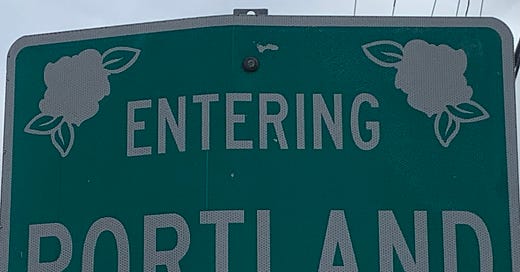Portland is in a ditch, not its grave
The city that used to work has marketable assets but needs a cheerleader and a plan to market them
Portland may be in a ditch but not its grave. It’s a city with marketable assets that has lost a coherent direction and doesn’t have a compelling cheerleader. It needs both to regain its mojo.
The city that once worked doesn’t seem to be working so well. A vaunted reputation for citizen involvement has morphed into community bickering. The aspiration as the creative capital of the world has given way to world-class frustration.
Portland’s problems aren’t just homeless people camping on city sidewalks or residents feeling unsafe at home or work because of shootings, car heists, organized retail theft and street racing. But, sadly, Portland cannot regain its promise until Portlanders feel safe.
It’s not enough to say other cities suffer similar problems (which they do). Portland needs to find solutions that work here. City officials don’t have to invent all the solutions. They can borrow strategies and programs that work elsewhere and could work here. Most important, city leaders and the community, the entire community, need to labor arm-in-arm to identify and implement solutions that will work here.
This community collaboration on public safety will become the first step toward reclaiming Portland’s reputation and pursuing its possibilities.
Finding the Right Examples
The three U.S. cities most often cited for their downtown turnarounds are Pittsburgh, Indianapolis and Detroit. Pittsburgh created a 14-block cultural district. Indianapolis developed an 8-mile cultural trail and banned cars on some downtown streets. Detroit’s Big Comeback involves luring big investors, housing projects and the Detroit Pistons to its battered downtown.
Now think about this. Portland has a Cultural District, old and new urban housing, walkability, public transit, sports venues and 5,000-acre Forest Park on the edges of its downtown.
Portland’s downtown is expanding to the north (The Pearl) and south (South Waterfront). Its Eastside is developing (convention center hotel and small business growth) and will blossom even more with a high-rise development providing 3 million square feet of new construction, including affordable housing, on 34 acres next to OMSI and a MAX stop.
Portland is not a Rust Belt relic or a hostage to car congestion or a financial wreck. We also aren’t Austin (state capital and top-tier university), Denver (a center of space technology) or Seattle (miles of beaches, a major plane manufacturer and home to many high-rollers).
Portland’s Attractive Assets
Portland has attractive assets. It is a short drive away from ski slopes and ocean beaches. Some of the world’s best wine can be found in its backyard. It has a sister city that just developed a cool new waterfront.
The city has attracted musicians, artists, chefs and entrepreneurs. The Portland region is one of nation’s largest semiconductor manufacturing hubs and home to innovative designers for specialty metals, creative advertising, sports shoes and electric trucks.
We don’t need gimmicks or even major investments. We just need an idea and the guts to go for it. Here are four suggestions for getting from here to somewhere better:
#1 Promote Portland as a mecca for young people
Portland is on the list of best cities for Millennials because of its casual, laid-back culture, green reputation, lack of a sales tax and appealing food and beer scene. It’s easy to get to ski slopes, the ocean beach, hiking trails, lakes and San Francisco. The streets are walkable, you can wear jeans to work and there are performance venues geared to young adults. Yes, housing is expensive but you don’t need to own a car. Plus, Portland is a city without all the big-city hassles.
Portland is also family-friendly with distinct neighborhoods, decent public schools, parks and lots of trees. Young adults can be restless and some will move away. But some will put down roots and stay. They will be the next generation of Portland business and civic leaders.
#2 Recruit business innovators who rely on young professionals
It’s time to resurrect the goal of making Portland the creative capital of the world by recruiting entrepreneurs and innovators who will create tomorrow’s mind-blowing marvels. Some of them may already be here and just need a confidence boost. Others can be recruited to join an intentional colony of creatives.
#3 Turn Portland’s growing diversity into a calling card
Portland is becoming more racially and ethnically diverse, which can be an advantage. Instead of arguing over City Council seats, turn diversity into a differentiator. Make Portland the city of tomorrow by helping its entire community realize their dreams in Portland.
#4 Find a city cheerleader
Look for a young Bud Clark who can be goofy, engaging and cagey all at once. Clark exposed the world to Portland’s art, championed a convention center to invite them to visit and balanced the city’s budget. He could walk into room with people thinking he was a buffoon and leave with everyone wanting to shake his hand. His is a hard personality to replicate, but there are people living here who can match Bud Clark’s charm and his insatiable desire to make Portland better.
Cities don’t become great overnight, and they don’t become great by accident. Unlike many cities in troubled waters, Portland doesn’t need a lifeboat. It just needs someone who can show everyone how to swim ashore.
Gary Conkling has been a newsman, congressional aide and public affairs professional for more than 50 years.
To read Mark Hester’s ideas for reviving Portland, click here.






I think all of those are great ... AND your first point is the most important - people need to feel safe. I used to spend weekends in downtown Portland but stopped because of the aggressive street people.